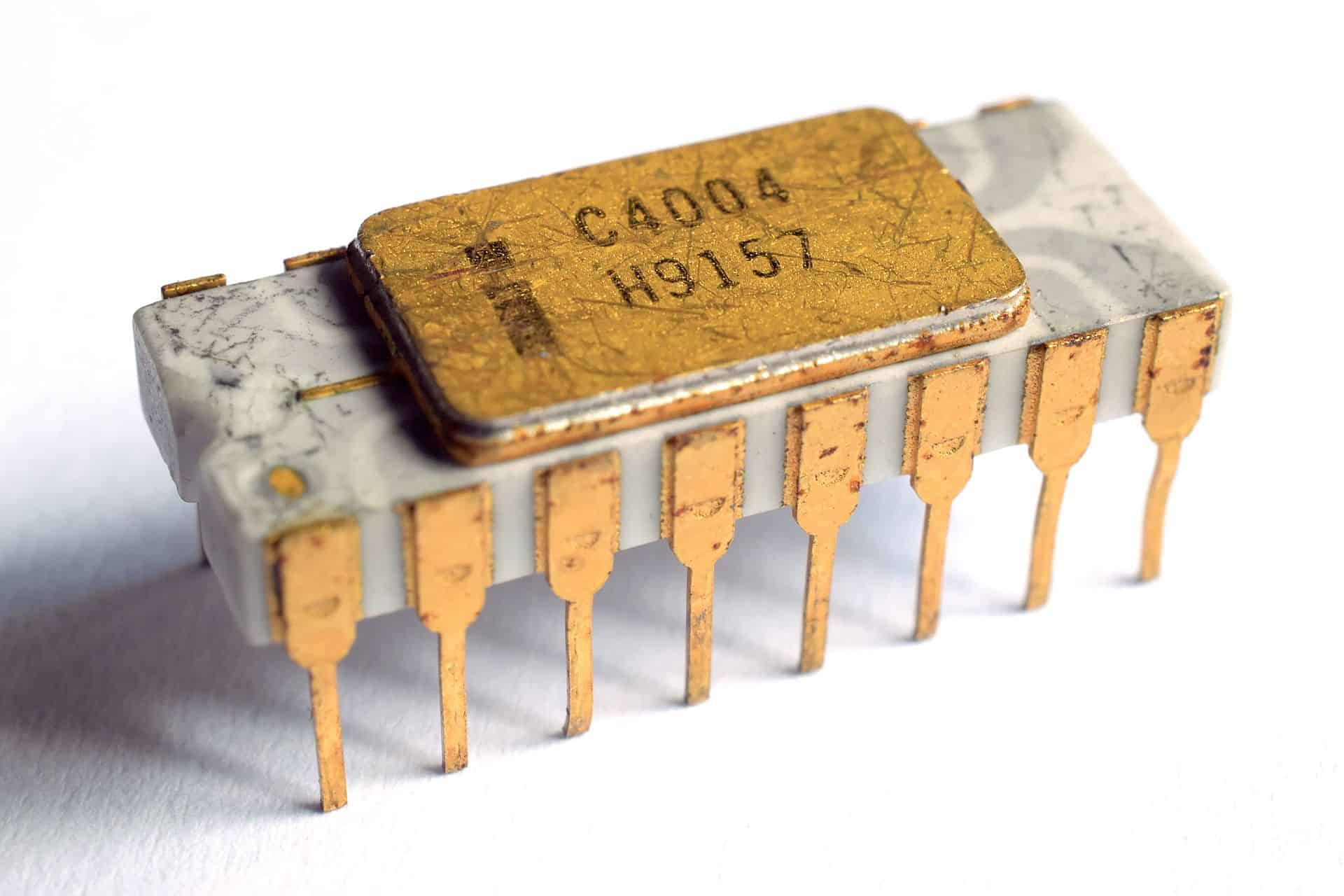In 1971, Intel released the Intel 4004, the first commercially produced 4-bit microprocessor, featuring 2,300 transistors. This innovation revolutionized computer design and marked a significant milestone in computing history. Sold for $60 at launch (approximately $450 today), the 4004 demonstrated the potential of integrated electronics.
Intel’s strategic acquisition of rights from Nippon Calculating Machine Corporation for calculator chips facilitated this development, laying the foundation for future advanced microprocessors and modern digital devices.
Hero Image By Stelo.xyz, Pttn, or Thomas Nguyen, CC BY-SA 4.0, Link
When Intel First Introduced the Microprocessor

Image Credit: Al. Struk, CC BY-SA 4.0 https://creativecommons.org/licenses/by-sa/4.0, via Wikimedia Commons
Intel’s introduction of the microprocessor marked a pivotal moment in the history of computing. This innovation paved the way for the personal computer revolution and the digital age we live in today. But when exactly did this groundbreaking event occur?
The Intel 4004: A Revolutionary Chip
Intel unveiled the world’s first commercially available microprocessor, the 4004, on November 15, 1971. This four-bit central processing unit (CPU) was a marvel of engineering for its time, packing 2,300 transistors onto a single chip. It was originally designed for a Japanese calculator company called Busicom.
Key Features of the Intel 4004
While relatively simple by today’s standards, the 4004 possessed several key features that set it apart:
- Four-bit architecture: It could process data in four-bit chunks.
- Clock speed of 740 kHz: This determined how fast the processor could execute instructions.
- Addressable memory of 640 bytes: This limited the amount of memory the processor could directly access.
The Impact of the 4004
The 4004’s significance extended far beyond its initial calculator application. It demonstrated the feasibility of integrating a computer’s central processing unit onto a single chip, opening up new possibilities for smaller, more affordable, and more powerful computing devices. This led to the development of:
- Personal computers: Microprocessors became the brains of early PCs, making computing accessible to individuals and small businesses.
- Embedded systems: Microprocessors found their way into various devices, from appliances to automobiles.
- The rise of the semiconductor industry: The 4004’s success spurred further innovation in semiconductor technology.
The Legacy Continues
The Intel 4004 was just the beginning. Intel continued to develop more advanced microprocessors, such as the 8008, 8080, and the x86 family of processors, which remain dominant in desktop and laptop computers today. The introduction of the 4004 laid the foundation for the modern computing landscape, forever changing the way we live, work, and interact with technology.
Intel’s Microprocessor Revolution: A Brief History
The Birth of the 4004
In 1971, Intel Corporation released the 4004, the world’s first commercially available microprocessor. This tiny chip, roughly the size of a fingernail, packed the power of a room-sized computer from the 1940s. Originally designed for a Japanese calculator company, the 4004 proved to be a groundbreaking innovation that paved the way for modern computing.
4004 Specifications
| Specification | Details |
|---|---|
| Architecture | 4-bit |
| Clock Speed | 740 kHz |
| Transistors | 2,300 |
| Instruction Set | 46 Instructions |
| Memory Address Space | 4 KB |
| Data Bus Width | 4-bit |
Impact on the World
The Intel 4004’s introduction marked the beginning of a technological revolution. It made computers smaller, cheaper, and more accessible to a wider audience. This led to the development of personal computers, smartphones, and countless other devices that rely on microprocessors.
Legacy
The Intel 4004 may seem primitive compared to today’s powerful processors, but its legacy lives on. It laid the foundation for the microprocessors that power our modern world. Intel’s pioneering work in this field has made them a leading force in the semiconductor industry, with their processors powering the vast majority of computers worldwide.
Note:
The information presented here is a brief overview of the Intel 4004 and its significance. For a more in-depth look, please refer to the resources mentioned earlier.
Key Takeaways
- Intel introduced the first microprocessor, the 4004, in 1971.
- The 4004 was a 4-bit CPU and a significant leap in integrated electronics.
- Intel’s pioneering move shaped the future of modern computing.
The Birth of the Microprocessor
The introduction of the microprocessor was crucial in shaping modern technology. This innovation streamlined computational processes and marked a significant leap forward in electronics.
Early Developments in Microprocessor Technology
The journey towards the microprocessor began with advancements in transistor technology. Transistors replaced vacuum tubes in the 1950s, leading to smaller, more reliable devices. Throughout the 1960s, engineers were able to pack more transistors onto integrated circuits (ICs), significantly increasing computing power.
In 1968, Bob Noyce co-founded Intel, aiming to push forward semiconductor technology. Ted Hoff, an Intel engineer, played a vital role in the development of integrated circuits, envisioning a universal processor that could be programmed for various tasks. His idea laid the groundwork for what would become the microprocessor.
Intel’s Pioneering Innovations
Intel’s breakthrough came in 1971 when it introduced the Intel 4004, the first commercially available microprocessor. This 4-bit CPU was a compact version of the multiple integrated circuits used at the time. The processor was initially created for the Busicom calculator.
Notably, Federico Faggin, an engineer at Intel, was instrumental in transforming Hoff’s idea into a functioning product. His work in silicon gate technology was key in the microprocessor’s success. The Intel 4004 could perform 92,000 operations per second, a feat that set the stage for further innovations.
The 4004 marked the beginning of a new era in electronics and laid the foundation for future advancements in computing technology.
Frequently Asked Questions
The Intel 4004 microprocessor marked a pivotal moment in technology in 1971. This section clarifies key details about its creator, technical specifications, applications, and the evolution of Intel processors.
Who invented the Intel 4004 microprocessor?
The Intel 4004 microprocessor was invented by Federico Faggin, Ted Hoff, and Stan Mazor. They designed it while working at Intel Corporation.
What were the specifications of the Intel 4004 chip?
The Intel 4004 was a 4-bit central processing unit (CPU). It ran at a clock speed of 740 kHz and processed about 60,000 instructions per second. It had 2,300 transistors.
What applications was the Intel 4004 microprocessor used for?
The Intel 4004 was initially designed for calculators. It also found use in other small devices like cash registers and automatic teller machines.
When was the first Intel Core processor introduced?
The first Intel Core processor was introduced in 2006. It marked a significant advancement in Intel’s processor technology.
Can you list the different generations of Intel processors?
Intel processors have evolved through several generations. Some notable ones include the 4004, 8008, 8086, Pentium, Core, Core 2, and various generations of Core i3, i5, and i7 processors.
How has the Intel microprocessor technology advanced since its inception?
Intel microprocessor technology has advanced with faster clock speeds, higher transistor counts, and greater energy efficiency. Modern processors also benefit from improved instructions per cycle (IPC), multi-core designs, and integrated graphics.







